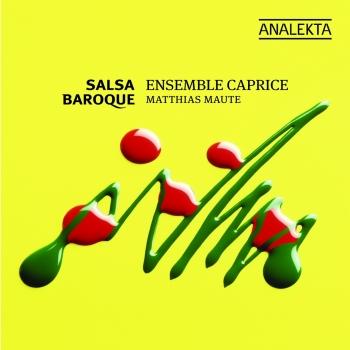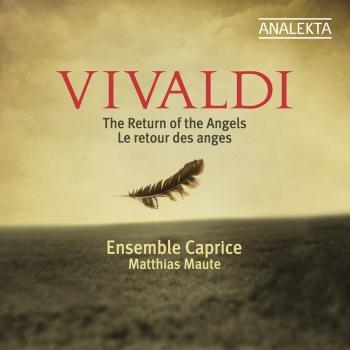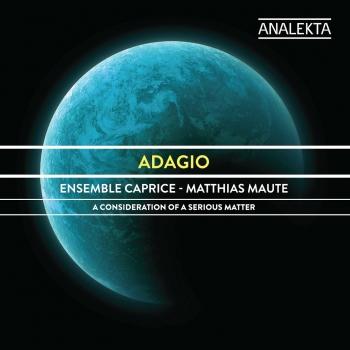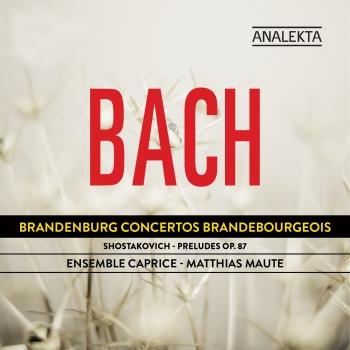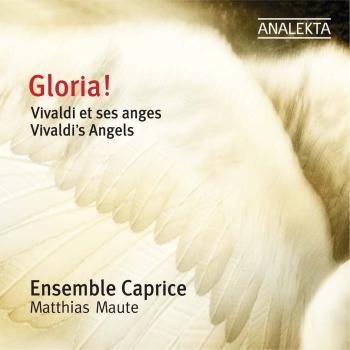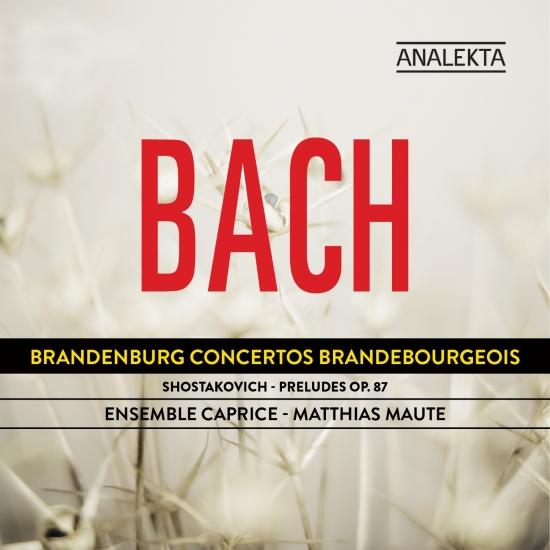
Bach: Brandenburg Concertos - Shostakovich: Preludes Op. 87 Ensemble Caprice & Matthias Maute
Album Info
Album Veröffentlichung:
2012
HRA-Veröffentlichung:
28.11.2019
Label: Analekta
Genre: Classical
Subgenre: Concertos
Interpret: Ensemble Caprice & Matthias Maute
Komponist: Dmitri Shostakovich (1906-1975), Johann Sebastian Bach (1685-1750)
Das Album enthält Albumcover
- Dmitri Shostakovich (1906 - 1975):
- 1Fugue Op. 87, No.702:20
- Johann Sebastian Bach (1685 - 1750): Concerto No. 1, BWV 1046:
- 2Concerto No. 1, BWV 1046: I. Allegro03:25
- 3Concerto No. 1, BWV 1046: II. Adagio03:10
- 4Concerto No. 1, BWV 1046: III. Allegro03:56
- 5Concerto No. 1, BWV 1046: IV. Menuetto05:55
- Dmitri Shostakovich:
- 6Prelude Op. 87, No. 1801:57
- Johann Sebastian Bach: Concerto No. 2, BWV 1047:
- 7Concerto No. 2, BWV 1047: I. Allegro04:31
- 8Concerto No. 2, BWV 1047: II. Andante02:57
- 9Concerto No. 2, BWV 1047: III. Allegro assai02:40
- Dmitri Shostakovich:
- 10Prelude Op. 87, No. 402:11
- Johann Sebastian Bach: Concerto No. 3, BWV 1048:
- 11Concerto No. 3, BWV 1048: I. Allegro04:29
- 12Concerto No. 3, BWV 1048: II. Adagio00:11
- 13Concerto No. 3, BWV 1048: III. Allegro04:06
- Dmitri Shostakovich:
- 14Prelude Op. 87, No. 501:27
- Johann Sebastian Bach: Concerto No. 4, BWV 1049:
- 15Concerto No. 4, BWV 1049: I. Allegro06:25
- 16Concerto No. 4, BWV 1049: II. Andante03:04
- 17Concerto No. 4, BWV 1049: III. Presto04:28
- Dmitri Shostakovich:
- 18Prelude Op. 87, No. 201:02
- Johann Sebastian Bach: Concerto No. 5, BWV 1050:
- 19Concerto No. 5, BWV 1050: I. Allegro08:53
- 20Concerto No. 5, BWV 1050: II. Affettuoso04:27
- 21Concerto No. 5, BWV 1050: III. Allegro05:06
- Dmitri Shostakovich:
- 22Prelude Op. 87, No. 1101:08
- Johann Sebastian Bach: Concerto No. 6, BWV 1051:
- 23Concerto No. 6, BWV 1051: I. Allegro04:32
- 24Concerto No. 6, BWV 1051: II. Adagio ma non tanto 03:44
- 25Concerto No. 6, BWV 1051: III. Allegro05:05
- Dmitri Shostakovich:
- 26Prelude Op. 87, No. 701:29
Info zu Bach: Brandenburg Concertos - Shostakovich: Preludes Op. 87
When J.S .Bach sent his carefully handwritten score of Six Concerts à plusieurs instruments to the margrave of Brandenburg in 1721, he could never have imagined that these pieces would become the most famous concertos of the Baroque period, a success perhaps only paralleled by that of Antonio Vivaldi’s legendary violin concertos The Four Seasons.
Yet it actually seems unlikely that this wonderful music was ever performed by the orchestra at the court of the margrave during Bach’s lifetime, and we can only be amazed at this strange fate of one of the greatest musical collections of all times.
The six concertos were composed between 1712 and 1721 for various unrelated occasions, but it was in keeping with Bach’s nature that he felt compelled, when he went about assembling them into one collection, to attach a particular overriding concept to the set.
In his dedication to the margrave of Brandenburg, Bach presented himself on the surface as the nobleman’s very humble and very obedient servant. This was standard practice, acquiescing to the strict hierarchical rules of the period according to which the nobility was considered to belong to the sphere of the gods; subordinate duties were left to people of lower social status, like musicians. However a closer look at the music itself reveals a strikingly different picture and one wonders if the full extent of its ramifications was actually understood by the dedicatee. If so, then we know for sure why these six concertos remained tucked away in a drawer of the court library!
According to the ideas of Michael Marissen, as set forth in his book The Social and Religious Designs of J.S. Bach’s Brandeburg Concertos, the six pieces move from a representation of stately sovereignty in the first concerto all the way down to a rather subversive situation in the sixth concerto, where the violas, traditionally associated with a lower musical status, take on the role of brilliant soloists, reigning over a small band of lower strings (gambas and cellos/violone). But here Bach pushed the envelope even further: written and performed at the court of Cöthen before being included in the collection of the Brandenburg Concertos, the piece was designed to fit a very specific configuration. Bach’s employer in Cöthen, Prince Leopold, was an amateur gambist who surely enjoyed performing from time to time with musicians of Bach’s caliber. Bach, the humble servant, dutifully obeyed, yet, once again, with a special twist: musically speaking, in the sixth Brandenburg Concerto the prince is demoted to a mere accompanist who is called upon to serve with straightforward repeated eighth notes the abundant and hence noble virtuosity of the eccentric viola parts. It is a world turned upside down, as is further demonstrated by the amusing fact that the gambists play the accompanying repeated eighth notes in the first movement with bow strokes opposite to those of the cello (up-down as opposed to down-up), thereby visually revealing their amateur status… Bach’s wit was indeed limitless!
This audacious concept was surely no call for social revolution but ultimately rather a subtle reminder for the prince, who could only have truly appreciated this dramatic shift of power by subscribing to the protestant view that redemption in paradise would reveal the real truth behind our own existence: in the realm of God, social differences among human beings no longer have any significance.
It is safe to say that Bach, even though labelling himself a humble servant in the dedication, was imbued with a deep-rooted sense of what legitimate authority really meant, believing in the almost religious power of music. This conviction was apparent in his personal life; during the period of roughly ten years during which the six concertos were written, Bach even went to prison rather than give in to a duke’s power! When in 1717 he decided to take a better position, at the court in Cöthen, the duke of Weimar, who wished Bach to stay in his service, put him in a prison cell and released him only after 30 days upon realizing that Bach’s stubbornness would outlast his own ducal fury.
This image of the young composer (in 1721 he was 36 years old) with a forceful will, a strong temper and an uncompromising readiness to meet all inevitable conflicts head on, was foremost in our minds throughout the recording sessions. It becomes apparent that, through his superlative use of complex musical strategies, Bach’s compositions are actually an accurate reflection of human conflicts and the potential to resolve them!
Let us follow this idea through the six concertos.
Although the hunting horns in the First Concerto represent the top of the power structure in an absolute monarchy – the royal hunt being the symbol and exclusive privilege of noblemen –, Bach does a masterful job of taming their power by integrating the horns slowly but surely into the overall structure. The initial overpowering hunting calls in the first movement are utterly unrelated to the musical material of both the orchestra and the other soloists, but in the course of the four movements, the horns gradually slip into the role of regular orchestra members, adjusting themselves to the sophisticated language of their environment and merely accompanying the final minuet with intentionally boring repeated notes.
In the Second Concerto (BWV 1047), where the trumpet represents royal authority in an even more direct way, Bach opts for a different strategy of integration. Right from the beginning the “noble” trumpet is paired with what are by definition three less distinguished solo instruments (violin, oboe, and recorder). Bach’s keen sense of humour is revealed in all its splendour when the listener realizes that the audacious and outrageously difficult passage work for the trumpet is the same material with which the other soloists shine throughout the piece but which is actually comparatively easy to play on their respective instruments. The noble trumpet has no more to say than the modest recorder, oboe or violin but is required to make an almost superhuman effort to say it!
The Third Concerto (BWV 1048) confronts three groups of string ensembles, including as many as nine independent lines plus a continuo line: three violins face three violas and three cellos in what might be one of Bach’s most compelling instrumental compositions. The obvious symbol for the Trinity (3 x 3 independent “solo” parts) paves the way for a depiction of highly dramatic action, where each single part gets a chance to contribute a solo statement to the rhetorically highly agitated “discussion”.
In the Fourth Concerto (BWV 1049), two recorders are paired with a solo violin. Although the solo violin part with its extravagant and incredibly virtuosic writing catches much of the listener’s attention (and deservedly so), the quiet symbolism of the recorder puts its unique stamp on this large-scaled concerto. For the 18th century listener the recorder would have represented love on the one hand, but also death on the other hand. This contrast leads to surprising rhetorical outbursts in the slow movement, and rather than merely being a means to accommodate the softer sound of the recorder, the extended unison passages of the two recorders in the last movement could stand for the symbolic apotheosis of unifying love (hence life) and death. Based on the religious views predominant in the 18th century there is actually nothing unusual about this abstract symbolism. What is exceptional is the way Bach manages to bring these ideas into play and, in so doing, create a musical masterpiece!
The Fifth Brandenburg Concerto (BWV 1050) was most likely written for a visit that Bach paid to the court of Dresden, where he would have had the occasion to perform with the renowned musicians of the court orchestra. It is impossible not to visualize J.S. Bach himself sitting at the harpsichord as the brilliant soloist of this fifth Brandenburg concerto. He clearly jumped at the chance to showcase his own virtuosic wizardry, leaving only relatively tame parts to the solo violin and solo flute.
+
Bach even adds an extended cadenza for solo harpsichord to the first movement, and we can easily imagine the uncomfortable shift in the balance of power this must have occasioned: the reputed members of the royal orchestra were condemned to listen silently and in awe as their young guest made an overwhelming impression with his eccentric high-wire act.
As mentioned beforehand, the Sixth Concerto (BWV 1051) can be seen as a final stage in the overturning of the established hierarchy. As in the First Brandenburg Concerto BWV 1046, the social phenomenon of the royal hunt is highlighted in this spirited piece, though in a totally different way. Whereas in BWV 1046 the two horns offer a glorious representation of noblemen, the Sixth Concerto promotes two servants (i.e. two violas) to the rank of king: the virtuosic canon at the beginning of the first movement is nothing other than a literal representation of a fierce and highly agitated hunt. It is only in the surprising unison passages for the two violas in the tutti sections of the last movement that we become aware that something has changed following the deeply contemplative discussion between the two violas that took place in the second movement. In that movement, the theme is clearly a musical representation of the most important symbol of Christianity, i.e. the cross. Reference to a higher power reigning over the planet from beyond the visible world is a regular feature of any upright Christian sermon. Therefore the unison passages in the concluding movement of the whole collection suddenly start to make sense. It is as if Bach wanted to say that we have finally reached common ground and that all our lives are based upon one single idea. Indeed, having explored matters of worldly power throughout the set of concertos, Bach establishes as a final conclusion the supremacy of religious power and the vanitas of our own mortal being. This conviction was held by all devout Christians of the 18th century.
We may or may not subscribe to this point of view. Ultimately, from a musical standpoint, it does not really matter. However, it is important to think of Bach’s thematic conclusion as a result of a process of ongoing transformation rather than a given condition. The music paints a rich landscape of conflicting ideas, which are explored in detail by means of the musical rhetoric so carefully applied to the score by Bach’s masterful hand.
But what does Dmitri Shostakovich have to do with Bach’s music?
When the Russian composer adjudicated at the International Johann Sebastian Bach Competition in Leipzig in 1950, he was deeply impressed by Bach’s two collections of the Well-tempered Clavier. Upon returning to Moscow, Shostakovich followed Bach’s example and composed his own cycle of preludes and fugues in all 24 keys. Even though he holds firmly to his own musical language with its tonal liberties, his use of baroque elements provides a constant source of surprise. The rhythmic flow of the independent melodic lines seems to imitate Bach’s vigorous use of complementary rhythms, thereby adding a great sense of direction to both the preludes and the fugues.
We have selected and orchestrated one prelude by Shostakovich for each of the Brandenburg Concertos. The First Brandenburg Concerto, however, is preceded instead by a fugue, the wonderful fugue Op.87 No.7. As a touch of post-modern thought we have reserved the prelude composed for this fugue to serve as a postlude at the end of the cycle of Brandenburg concertos. This short but utterly beautiful and contemplative piece seems to be Shostakovich’s final personal comment on Bach’s overwhelming music, as seen from a contemporary point of view.
Ensemble Caprice
Matthias Maute, conductor
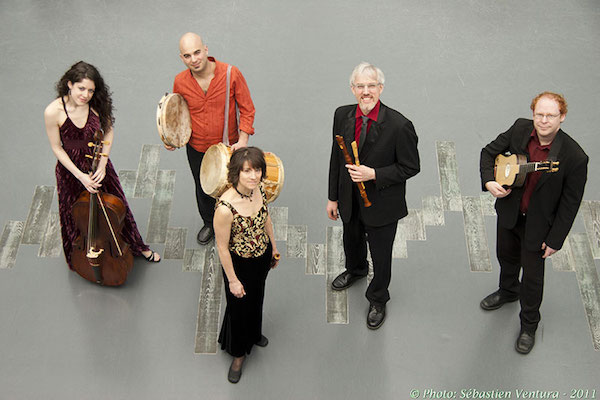 Ensemble Caprice
Ensemble Caprice
a baroque ensemble which performs on period instruments, was founded by acclaimed conductor, composer and recorder soloist Matthias Maute and has become known for its innovative and adventuresome approach to an increasingly expanding musical repertoire. In addition to its series of concerts in Montreal, the group tours extensively, giving dozens of concerts in Canada, the USA, Europe, and even Asia. The ensemble is a regular guest at many prestigious European festivals: the Lufthansa Festival of Baroque Music in London, the Bruges (Belgium) and Utrecht (Netherlands) festivals, the Felicja Blumenthal International Music Festival in Tel Aviv; and in Germany, the Musikfestspiele Potsdam Sanssouci, the Regensburg Early Music Festival, the Händel-Festspele in Halle, and the Stockstadt festival. In November 2009, the New York Times published a lengthy article hailing the musicians’ innovative and refreshing approach, praising them as “imaginative, even powerful; and the playing is top-flight”.
The Ensemble’s recording activity is every bit as impressive. Their albums have gained many honours and much critical acclaim. The CD Gloria! Vivaldi and his Angels received a JUNO Award and three prestigious Prix Opus awards. Ensemble Caprice was also recognized for its artistic approach and the quality of its performances by being selected “People’s choice” and was a finalist in the music category for the Montreal Arts Council’s Grand Prix de Montréal. The group also earned a nomination for the Echo Klassic award in Germany and the acclaimed publication Gramophone magazine chose the group’s CD Telemann and The Baroque Gypsies as one of its recommended recordings. Ensemble Caprice produces videos for the website noncerto which promote classical music in a new way.
Matthias Maute
JUNO Award winning conductor, composer, recorder and flute soloist Matthias Maute has achieved an international reputation. Impressed by his artistic approach, The New York Times described the orchestra he conducts, Ensemble Caprice, as being “an ensemble that leads the listener to rehear the world”. He regularly appears at major festivals. In Canada he has performed at the Ottawa International Chamber Music Festival, the Festival international du Domaine Forget and the Elora Festival among others.
Maute’s recording of Bach’s Brandenburg Concertos juxtaposed with (his own orchestral arrangements of) Preludes from Shostakovich’s Op. 87 was hailed by The New Yorker’s Alex Ross as standing out “for its fleet, characterful approach” and “its fresh, vibrant colors”. Matthias Maute’s compositions are published by Breitkopf & Härtel, Amadeus, Moeck and Carus. His compositions are featured in numerous videos on the noncerto website. In 2014 and 2015, Maute’s 1st Violin Concerto was performed by soloist Mark Fewer and the St. John’s Symphony as well as by I Musici de Montréal. Matthias Maute has made some twenty recordings. He currently teaches in Montreal at both the Université de Montréal and McGill University.
Sophie Larivière
has participated in the International Recorder Symposium in Stuttgart, the Recorder Series in Schwelm, and the Recorder Festival of Stockstadt in Germany. She has been a member of Ensemble Caprice since 1997 and is the artistic co-director. In this function, she has contributed to the enrichment of the Ensemble, leading audiences to musical discoveries featuring both virtuosity and artistry. She has also been a guest performer with several early music ensembles, including Arion, Le Concert Spirituel, Les Idées Heureuses, Les Violons du Roy, Rebel, Le Studio de Musique Ancienne de Montréal, the New York Collegium and the Theatre of Early Music. In 2003 and 2004, under Jeunesses Musicales du Canada’s tutelage, Larivière took part in some 30 concerts throughout Quebec, Ontario and New Brunswick. In June 2004, with Ensemble Caprice, she performed for the first time in Austria, and few months later took part in a series of concerts at the Boston Early Music Festival. In the fall of 2006, she made her debut in Israel with the Ensemble Caprice in a series of concerts in Tel Aviv and Yehiam.
With Le Concert Spirituel (Paris), she took part in an American tour that led her to Detroit, Chicago and Washington. She has performed under such renown conductors as Andrew Parrott, Hervé Niquet, Philipp Picket, Jaap ter Linden and Barthold Kuijken, She is second traverso of the REBEL Baroque Orchestra in New York under the direction of Owen Burdick. She has recorded with Ensemble Caprice, Arion, Rebel, the Theatre of Early Music, and the Violons du Roy.
Dieses Album enthält kein Booklet











